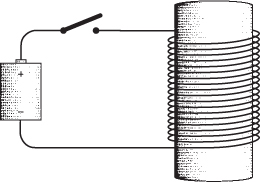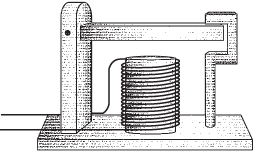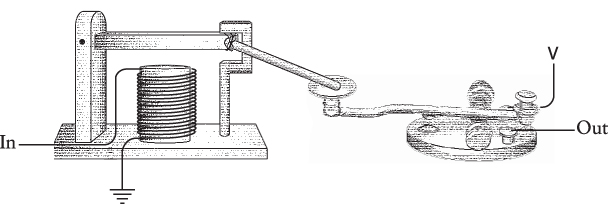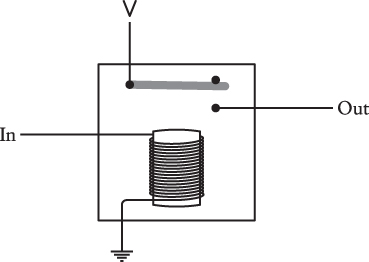Chapter Seven
Telegraphs and Relays
Samuel Finley Breese Morse was born in 1791 in Charlestown, Massachusetts, the town where the Battle of Bunker Hill was fought and which is now the northeast part of Boston. In the year of Morse’s birth, the United States Constitution had been in effect just two years and George Washington was serving his first term as president. Catherine the Great ruled Russia. In France, the Revolution was still in progress, and Louis XVI and Marie Antoinette would be marched to the guillotine two years later. In 1791, Mozart completed The Magic Flute, his last opera, and died later that year at the age of 35, but the 20-year-old Beethoven was already being noticed.
Morse was educated at Yale and studied art in London. He became a successful portrait artist. His painting General Lafayette (1825) hangs in New York’s City Hall. Much more personal is his final painting: a portrait of his daughter Susan entitled The Muse, on display at the Metropolitan Museum of Art.
Morse was also an early photography buff. He learned how to make daguerreotype photographs from Louis Daguerre himself and created some of the first daguerreotypes in America. In 1840, he taught the process to the 17-year-old Mathew Brady, who with his colleagues would be responsible for creating the most memorable photographs of the Civil War, Abraham Lincoln, and Samuel Morse himself.

ullstein bild Dtl/Getty Images
But these are just footnotes to an eclectic career. Samuel Morse is best remembered these days for his invention of the telegraph and the code that bears his name.
The instantaneous worldwide communication we’ve become accustomed to is a relatively recent development. In the early 1800s, you could communicate instantly and you could communicate over long distances, but you couldn’t do both at the same time. Instantaneous communication was limited to as far as your voice could carry (no amplification available) or as far as the eye could see, aided perhaps by a telescope. Communication by letter over longer distances took time and involved horses, trains, or ships.
For decades prior to Morse’s invention, many attempts were made to speed long-distance communication. Technically simple methods employed a relay system of men standing on hills waving flags in coded patterns known as semaphore. More complex solutions used large structures with movable arms but which did basically the same thing as men waving flags.
The idea of the telegraph (literally meaning “far writing”) was certainly in the air in the early 1800s, and other inventors had taken a stab at it before Samuel Morse began experimenting in 1832. In principle, the idea behind an electrical telegraph was simple: You do something at one end of a wire that causes something to happen at the other end of the wire. This is exactly what we did in Chapter 5 when we made a long-distance flashlight. However, Morse couldn’t use a lightbulb as his signaling device because a practical one wouldn’t be invented until 1879. Instead, Morse relied upon the phenomenon of electromagnetism.
The Danish physicist Hans Christian Ørsted is credited with the first systematic exploration of the relationship between electricity and magnetism. A paper he published in 1820 showed how an electrical current could deflect the magnetized needle of a compass. Thereafter, the phenomenon engaged the best minds of 19th century science, including Michael Faraday and James Clerk Maxwell, whose 1873 Treatise on Electricity and Magnetism remains a classic of mathematical physics. But by that time, ingenious innovators such as Samuel Morse had long been using electromagnetism in their clever inventions. If you take an iron bar, wrap it with a couple of hundred turns of thin insulated wire, and then run a current through the wire, the iron bar becomes a magnet. It then attracts other pieces of iron and steel. Remove the current, and the iron bar loses its magnetism:

This might look like a short circuit, but the wire wrapped around the iron bar is usually very thin, and there’s enough of it to constitute sufficient electrical resistance.
The electromagnet is the foundation of the telegraph. Turning the switch on and off at one end causes the electromagnet to do something at the other end.
Morse’s first telegraphs were actually more complex than the ones that later evolved. Morse felt that a telegraph system should actually write something on paper, or as computer users would later phrase it, “produce a hard copy.” This wouldn’t necessarily be words, of course, because that would be too complex. But something should be written on paper, whether it be squiggles or dots and dashes. Notice that Morse was stuck in a paradigm that required paper and reading, much like Valentin Haüy’s notion that books for blind people should use raised letters of the alphabet.
Although Samuel Morse notified the patent office in 1836 that he had invented a successful telegraph, it wasn’t until 1843 that he was able to persuade Congress to fund a public demonstration of the device. The historic day was May 24, 1844, when a telegraph line rigged between Washington, D.C., and Baltimore, Maryland, successfully carried a biblical message from Numbers 23:23: “What hath God wrought!”—not a question but meaning “Look what God has done!”
The traditional telegraph “key” used for sending messages looks like this:

Despite the fancy appearance, this is just a switch designed for maximum speed. The most comfortable way to use the key for long periods of time is to hold the handle between thumb, forefinger, and middle finger and tap it up and down. A short tap produces a Morse code dot, and a longer tap a Morse code dash.
At the other end of the wire was a receiver that was basically an electromagnet pulling a metal lever. Originally, the electromagnet controlled a pen. As the pen bounced up and down, it drew dots and dashes on paper from a roll that was slowly pulled by a wound-up spring. A person who could read Morse code would then transcribe the dots and dashes into letters and words.
Of course, we humans are a lazy species as well as an ingenious one, and telegraph operators soon discovered that they could transcribe the code simply by listening to the pen bounce up and down. The pen mechanism was eventually eliminated in favor of the traditional telegraph “sounder,” which looked something like this:

That bar at the top was normally held in the horizontal position by a weight or spring inside the vertical part at the left, but it could also pivot. When the telegraph key was pressed, the electromagnet pulled the pivotable bar down and it made a “click” noise. When the key was released, the bar sprang back to its normal position, making a “clack” noise. A fast “click-clack” was a dot; a slower “click…clack” was a dash.
The key, the sounder, a battery, and some wires can be connected just like the lightbulb telegraph in the preceding chapter:

As we discovered, you don’t need two wires connecting the two telegraph stations. One wire will suffice if the voltage is high enough and the earth provides the other half of the circuit.
As we did in Chapter 5, we can replace the battery connected to the ground with a capital V. So the complete one-way setup looks something like this:

Two-way communication simply requires another key and sounder. This is similar to what we did earlier.
The invention of the telegraph truly marks the beginning of modern communication. For the first time, people were able to communicate farther than the eye could see or the ear could hear and faster than a horse could gallop. That this invention used a binary code is all the more intriguing. In later forms of electrical and wireless communication, including the telephone, radio, and television, binary codes were abandoned, only to later make an appearance in computers, followed by many other binary codes in virtually all kinds of electronic media.
Morse’s telegraph triumphed over other designs in part because it was tolerant of bad line conditions. If you strung a wire between a key and a sounder, it usually worked. Other telegraph systems were not quite as forgiving. But as I discussed in Chapter 5, the longer a length of wire becomes, the more resistance it has to the flow of electricity. This was a major impediment to long-distance telegraphy. Although some telegraph lines used up to 300 volts and could work over a 300-mile length, wires couldn’t be extended indefinitely.
One obvious solution is to have a relay system. Every couple of hundred miles or so, a person equipped with a sounder and a key could receive a message and resend it.
Now imagine that you have been hired by the telegraph company to be part of this relay system. They have put you in a little hut with a table and a chair somewhere between New York and California. A wire coming through the east window is connected to a sounder. Your telegraph key is connected to a battery and wire going out the west window. Your job is to receive messages originating in New York and to resend them, eventually to reach California. An identical configuration relays messages from California to New York.
At first, you prefer to receive an entire message before resending it. You write down the letters that correspond to the clicks of the sounder, and when the message is finished, you start sending it using your key. Eventually you get the knack of sending the message as you’re hearing it without having to write the whole thing down. This saves time.
One day while resending a message, you look at the bar on the sounder bouncing up and down, and you look at your fingers bouncing the key up and down. You look at the sounder again, and at the key again, realize that the sounder is bouncing up and down the same way the key is bouncing up and down. So you go outside and pick up a little piece of wood and you use the wood and some string to physically connect the sounder and the key:

Now it works by itself, and you can take the rest of the afternoon off and go fishing.
It’s an interesting fantasy, but in reality Samuel Morse had understood the concept of this device early on. The device we’ve invented is called a repeater, or a relay. A relay is like a sounder in that an incoming current is used to power an electromagnet that pulls down a metal lever. The lever, however, is used as part of a switch connecting a battery to an outgoing wire. In this way, a weak incoming current is “amplified” to make a stronger outgoing current.
Drawn rather schematically, the relay looks like this:

When an incoming current triggers the electromagnet, it pulls down a pivoting or flexible metal bar that acts like a switch to turn on an outgoing current:

The words In and Out are descriptive of the way that the telegraph line comes through one window of your hut and leaves through the opposite window, but they can also serve as convenient abbreviations for input and output. These are electrical signals. The signal labeled In causes a change in the signal labeled Out. It’s a cause and effect.
The relay is a remarkable device. It’s a switch, surely, but a switch that’s turned on and off not by human hands but by an electrical current. You could do amazing things with such devices. You could actually assemble much of a computer with them.
Yes, this relay thing is much too sweet an invention to leave sitting around the telegraphy museum. Let’s grab one and stash it inside our jacket and walk quickly past the guards. An idea is brewing in our minds.
